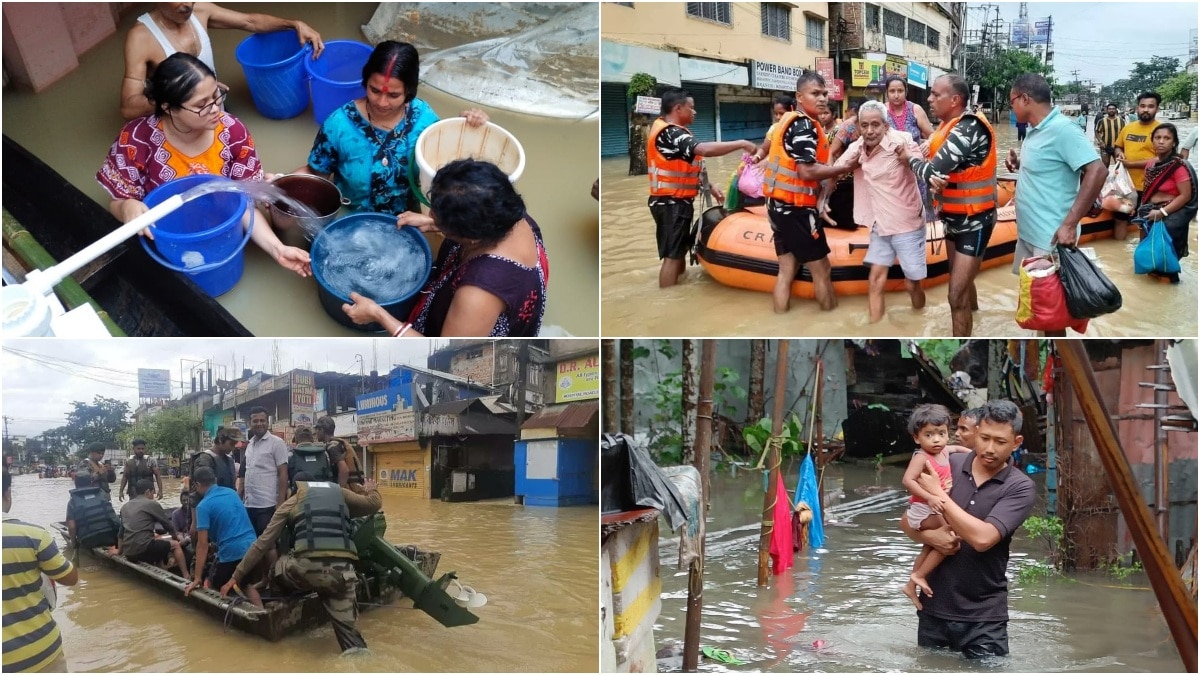Why is Assam flooding? The Brahmaputra, climate change and poor infrastructure

Floods have ravaged the Northeastern state of Assam. Photo: @sdma_assam/Twitter
Assam is reeling under one of the worst floods ever seen in the region. This is the second time floods have hit Assam since May. As of June 27, 127 people have been killed in the floods and lakhs have been displaced and are without food, water or electricity. At least 28 districts and some 33 lakh people are still affected by the floods.
The total population affected by the floods, however, declined to 33.03 lakh in 28 districts as against the previous day’s figure of 45.34 lakh in 30 districts, a bulletin issued by the Assam State Management Disaster Authority (ASDMA) said.
The extent of destruction: Reports say around 1.08 lakh hectares of crops have been damaged so far. Over 5,000 villages have been inundated. Around 2.7 lakh people have been moved to rescue shelters. The destruction is not limited to humans, some 60,000 animals have also been reportedly killed. 36 lakh animals are currently affected by the floods. At least 15 per cent of Kaziranga National Park has been flooded.
Assam govt to start the damage assessment occurred by recent flood in the state.
— Assam State Disaster Management Authority (@sdma_assam) June 25, 2022
Read more #AssamFloods #DisasterManagement #disasterpreparedness #FloodReport #assamfloods2022 pic.twitter.com/w6XXsTvkG1
Why did the floods occur? Flood and destruction in Assam is an annual event. Nearly 40 per cent of Assam’s land is said to be flood-prone. Assam makes up 10 per cent of the country’s total flood-prone area.
Usually, the southwest monsoon season brings floods to the low-lying regions of Assam. There was once a time when the people of Assam would await floods, as the water rich in minerals would improve the croplands. However, lately, the floods have turned more destructive than helpful.
The main cause of flooding in Assam year after year is the Brahmaputra river and the incessant rains. Brahmaputra river is the major water body that crisscrosses through the floodplains. Originating in the Himalayas, the river brings heavily sedimented water to Assam. The sedimentation increases as glaciers melt in summer and the soil erodes. The heavy sedimentation reduces the river’s capacity to carry water but raises the level of water.
When it rains in the northeastern region, the river gets full easily and excess water results in flooding of nearby areas. It’s not just the Brahmaputra river at play, there is another major river called Barak. And there are 50 tributaries swelling these rivers.
Climate Change: Down To Earth reported that climate change is resulting in the monsoon winds from the Bay of Bengal carrying an increasing amount of moisture towards the northeastern region, in turn resulting in heavy rainfall.
Poor Infrastructure: Down To Earth has also reported that the embankment mechanism used in Assam to protect areas from flooding is not working. This time around, embankments in nearly 20 districts were breached, with Darrang being the worst affected.
As of now, the government’s efforts have been in rescue operations across Assam. The state also reports a loss of nearly Rs 200 crore due to the annual floods.

